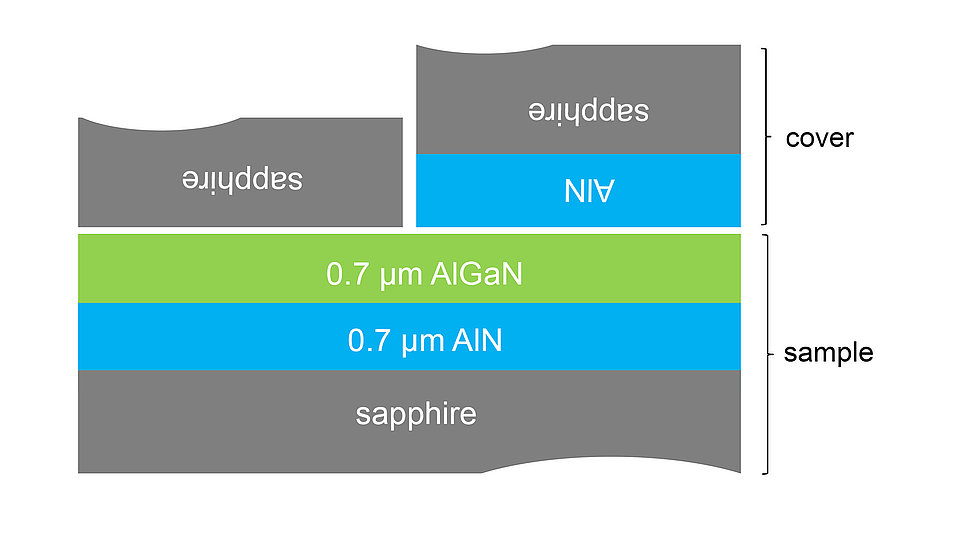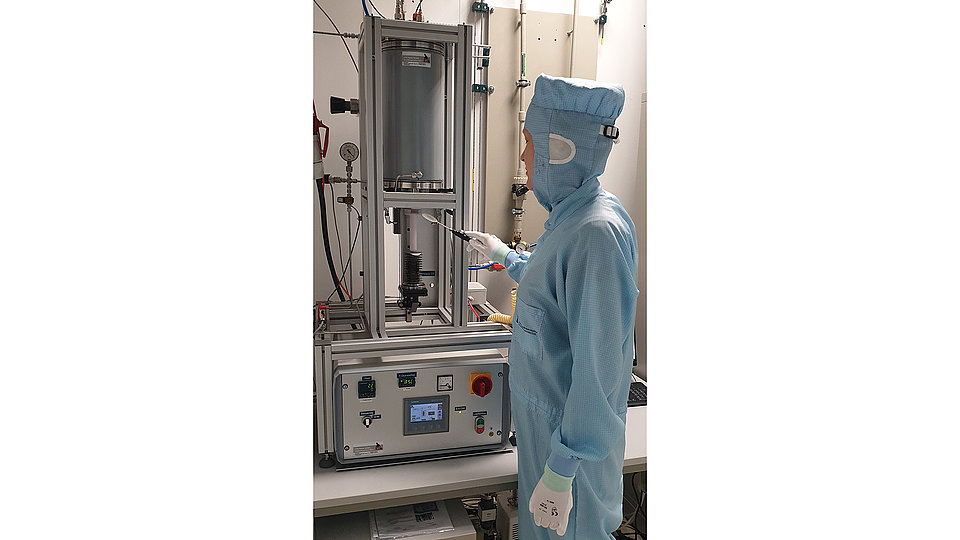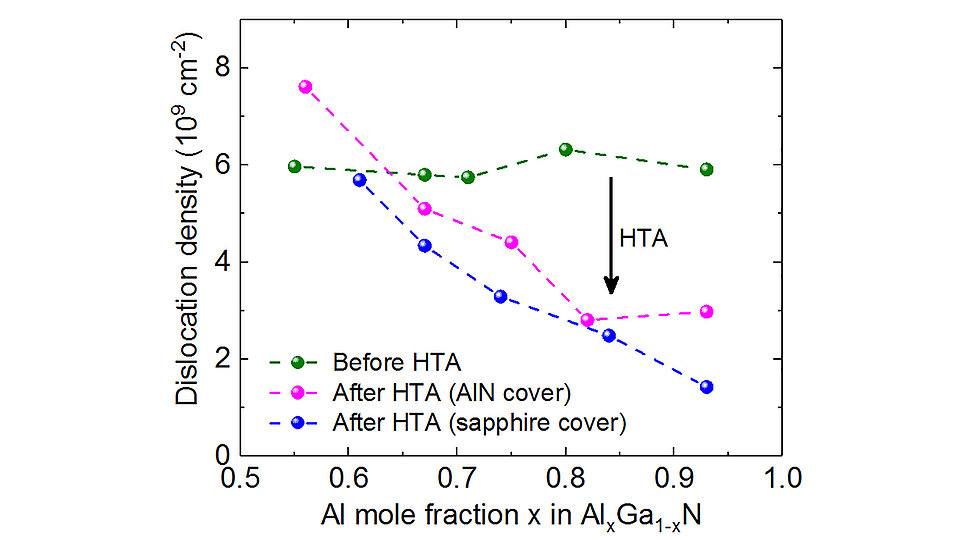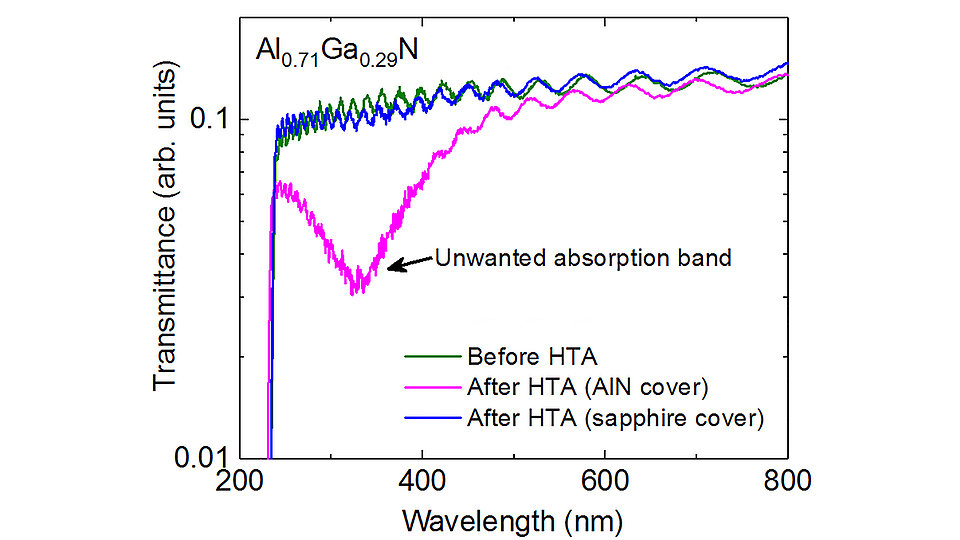A new route to lattice-matched base layers for UV LEDs – the role of oxygen in high-temperature annealing of AlGaN
Fig. 3: Threading dislocation density of AlGaN plotted against the Al mole fraction x before and after HTA using sapphire or AlN as cover material.
Ultra-violet light emitting diodes (UV LEDs) based on aluminum gallium nitride (AlGaN) find a wide range of applications, including biological sensing, optical data communication, medical treatments, and sterilization. However, the efficiency of UV LEDs emitting in the UVB and UVC spectral range still needs to be significantly increased. One of the approaches to achieve this goal is to develop AlGaN-based UV LEDs on low threading dislocation density (TDD) AlGaN layers. It is challenging to reduce the TDD in AlGaN layers especially when grown on the commonly used aluminum nitride (AlN) buffer layers. This is associated to the crystal lattice mismatch between AlGaN and AlN that becomes larger with increasing Ga content. Moreover, relaxation of AlGaN when growing the layers above a critical thickness will lead to surface roughening and generation of new dislocations. These subsequently damage the active region where the light is emitted, which renders the material useless for device production.
High-temperature annealing (HTA) up to 1750 °C is a powerful technique to decrease the TDD in AlN layers. We have several years of experience in using this technique and have also expanded it to AlGaN. To preserve the AlGaN surface from heat damage during HTA, we have investigated different cover materials from which AlN and sapphire (Al2O3) proved to be the most promising ones. A schematic drawing of the sample arrangement during HTA experiments is given in Fig. 1. In particular, HTA was conducted in a nitrogen purged atmospheric pressure oven (Fig. 2) at 1680 °C for different AlxGa1-xN Al mole fractions x (0.55 < x < 0.93). Before HTA, the threading dislocation density (TDD) in AlGaN for all values of x was about 6.0 × 109 cm-2. After HTA, the sapphire cover led to a more efficient TDD reduction than the AlN cover, yielding 5.7 × 109 cm-2 for the lowest x of 0.55 and 1.4 × 109 cm-2 for the highest x of 0.93 (Fig. 3). Furthermore, strain relaxation in AlGaN increased by HTA, especially when using the sapphire cover. This results in the targeted larger in-plane lattice constant compared to the underlying AlN buffer layer. Due to the lower binding energy between Ga-N compared to Al-N, formation of empty lattice sites (vacancies) causes optical absorption in HTA AlGaN, especially when annealed with an AlN cover (Fig. 4). Such absorption compromises the performance of UV LEDs which usually emit through the substrate. By using the sapphire cover, this absorption can be suppressed.
In a nutshell, using a sapphire cover for HTA of AlGaN leads to lower TDD and maintains the transparency compared to AlGaN annealed with AlN cover material. These advantages of sapphire over AlN as a cover in the HTA process are related to the additional oxygen stemming from the sapphire cover and diffusing into the AlGaN layer. Moreover, decreasing the TDD by HTA of thin AlGaN layers reduces the wafer bow compared to conventional thick low TDD AlGaN buffer layers. This simplifies handling and improves homogeneity in subsequent device heterostructure growth and processing.
The work was partially funded by the German Federal Ministry of Education and Research (BMBF) within the “Advanced UV for Life” project (No. 03ZZ0134B) and financially supported by the Alexander von Humboldt Foundation (Georg Forster Research Fellowship of Norzaini Zainal).
Publication
N. Zainal, S. Hagedorn, C. Netzel, A. Mogilatenko, M. Schön, M. Weyers, Role of oxygen in high-temperature annealing of aluminum gallium nitride, Phys. Status Solidi A, preprint (2023). https://doi.org/10.1002/pssa.202300083



